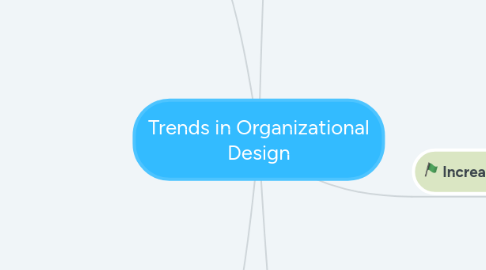
1. Becoming horizontal & adaptive
1.1. Change from mechanistic design to organic design.
1.2. Mechanistic design
1.2.1. (a) thrive in stable environment.
1.2.2. (b) good at doing routine things in predictable situation.
1.3. Organic design
1.3.1. (a) adaptable and better suit to handle change and less predictable situation.
1.3.2. (b) empower employee by increasing their independence and responsibility.
1.3.3. (c) improvement can adopt quickly because no red tape stand in the way.
1.3.4. (d) enhance communication and operation.
1.3.5. (e) commitment and moral are high.
2. Using alternative work schedules
2.1. Categories of alternate work
2.1.1. (a) Compressed workweek
2.1.1.1. Allows a worker to complete a full time job in less than 5 days.
2.1.2. (b) Flexible working hours
2.1.2.1. Give employees some choice in daily work hours.
2.1.3. (c) Telecommuting
2.1.3.1. Use IT to work at home or outside of the office.
2.1.4. (d) Job sharing
2.1.4.1. Splits one job between two or more people.
2.2. Advantages
2.2.1. (a) better teamwork.
2.2.2. (b) more productive work force in the company.
2.2.3. (c) a wider talent pool.
2.2.4. (d) reduces turnover and hiring costs.
2.3. Disadvantages
2.3.1. (a) some people take advantage of the flexibility.
2.3.2. (b) have trouble adjusting a new management style which requires thrust.
3. Becoming flatter
3.1. Definition
3.1.1. Fewer levels and wider spans of control (number of persons directly reporting to a manager).
3.2. Advantages
3.2.1. (a) elevates the employees level of responsibility in an organization.
3.2.2. (b) fewer level of management encourage easier decision making.
3.2.3. (c) eliminates salary of middle management.
3.3. Disadvantages
3.3.1. (a) employees often lacks specific boss to report to.
3.3.2. (b) produces a lot generalists but no specialist.
3.3.3. (c) limits long term growth of an organization.
3.3.4. (c) larger organization struggle to adapt the flat structure.
4. Increasing decentralization
4.1. Definition
4.1.1. Top management allows lower level to help make any decision.
4.2. Advantages
4.2.1. (a) more efficient decision making with a centralized structure.
4.2.2. (b) burden of daily business operations of the business owner is relieved.
4.2.3. (c) employees can be empowered by having more autonomy to make their own decision makings.
4.3. Disadvantages
4.3.1. (a) increases problems of coordination among the various limits.
4.3.2. (b) high cost of operation due to specialist in each department.
4.3.3. (c) unsuitable for small firms.
4.3.4. (d) self centered attitude among the departments.
5. Increasing delegation & empowerment
5.1. Definition
5.1.1. Delegation: process of entrusting work to others.
5.1.2. Empowerment: a way of unlocking talent and motivation.
5.2. Advantages
5.2.1. (a) increase productivity and moral.
5.2.2. (b) improve quality and helps business to meet goals.
5.3. Disadvantages
5.3.1. (a) delegation requires considerable amount of time.
5.3.2. (b) delegation will sacrifice quality for the sack of efficiency.
5.3.3. (c) high chances of miscommunication to occur with delegation.
